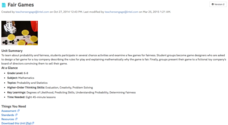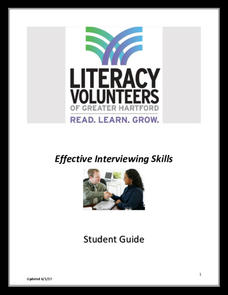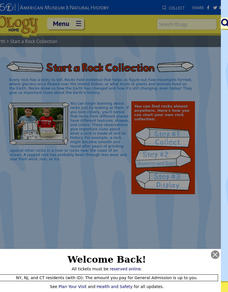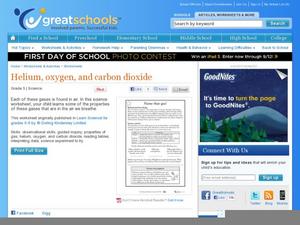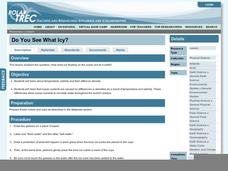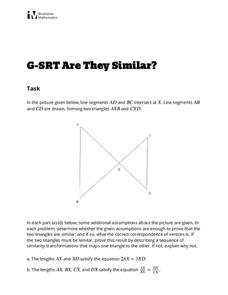Turabian Teacher Collaborative
Introductions: Formulating Problem Statements
Describing a problem efficiently doesn't solve it, but a well-crafted argument can move readers to action. High schoolers focus on structuring problem statements by reading examples of strong essays and working in groups to create...
Inside Mathematics
Graphs (2006)
When told to describe a line, do your pupils list its color, length, and which side is high or low? Use a worksheet that engages scholars to properly label line graphs. It then requests two applied reasoning answers.
Teach Engineering
Restriction Enzymes and DNA Fingerprinting
Show your class why restrictions aren't always a bad thing. In the third segment of a four-part series, the instructor develops the idea of restriction enzymes. Pupils learn how scientists use restriction enzymes in DNA analysis and DNA...
Intel
Fair Games
Who said things were fair? The unit introduces probability and its connection to fairness. The class interacts with activities of chance and plays games to relate them to fairness. Groups design a fair game and develop a presentation....
Classics for Kids
Listen to the Music
Different pieces of music can elicit different emotions from audience members. A quick tempo can make you feel happy, while a largo piece may bring out a melancholy temperament. Elementary musicians learn more about the instruments...
Novelinks
Words by Heart: Guided Imagery
Sad, depressed, miserable, inconsolable, forlorn: so many synonyms have a lot of variety with their connotations. Through the guided imagery activity, writers explore the use of connotation and its influence on imagery and description by...
Literacy Volunteers of Greater Hartford
Effective Interviewing Skills
Wearing wrinkled clothing and chewing gum are two things not to do at an interview. Pupils discover the steps to an effective job interview with the informative lesson plan. They read a sample interview and then practice their...
Discovery Education
The Time of Our Life
Mammals are some of the newest organisms to appear on Earth. Young scholars complete an activity that results in a timeline showing the appearance of different types of living organisms. Provided with a list that spans from prokaryotes...
American Museum of Natural History
Optical Illusions and How They Work
Illusions are what your mind makes them. Learners view several optical illusions. After each illusion the resource describes what is seen and the potential connection to evolution of the brain. Illusions include seeing different objects...
American Museum of Natural History
Start a Rock Collection
Rocks hold evidence of Earth's past. A three-step guide describes the process of creating a rock collection. It provides a data collection sheet to make notes about each sample.
K12 Reader
Using a Timeline
Introduce you primary graders to timelines with a worksheet that not only explains what this convenient tool is and how it can be used, but also describes how to construct one.
K12 Reader
The Scientific Method
Introduce the scientific method with a reading comprehension activity. Have kids read a few paragraphs that describe the process of making a hypothesis, gathering evidence, and taking notes that will support the experiment.
Curated OER
Reading Comprehension
Develop reading comprehension skills with this reading passage and the multiple choice questions that follow. There are only five questions, but the answer sheet is incredibly helpful, as it describes how to find each answer in the text....
Curated OER
Sentence Completion 7: High-Intermediate Level
Need another sentence completion worksheet? The great thing about this one is the extensive answer/explanation key that accompanies the exercise. The key pinpoints the clues, strategies, and logic used to determine the...
Curated OER
For a Change
Here is a worksheet that has young scientists think about things that been changed as a result of heating and cooling, and if they can be returned to their original form. There are seven scenarios to consider, and they must choose,...
Curated OER
Name That Gas!
Young scientists discover that air is a mixture of different gases - mainly nitrogen and oxygen. The properties of some of the other gases found in oxygen are listed in a table, then learners must decide which one of those gases is...
Worksheet Web
Language – Debating
Having a debate doesn't mean you're fighting. Introduce middle schoolers to debate with a resource which distinguishes between an quarrel and a debate, describes the debate process and format, and presents some possible debate topics.
Shmoop
ELA.CCSS.ELA-Literacy.W.9-10.6
Make the move toward incorporating more technology in your classroom and help to prepare your class for the professional world. Here is a resource that describes the Common Core standard while incorporating technology and English...
Polar Trec
Do You See What Icy?
Here is a lesson that kicks off with a question. "How does ice floating on the ocean act as it melts?" As learners investigate this natural phenomenon, they'll discover that it has a lot to do with temperature, salinity, and the effect...
Baylor College
What's That Food?
Get things cooking with the first instructional activity in this series on the science of food. Working in small groups, young scientists make and record observations about different mystery foods. These descriptions are then shared with...
Curriculum Corner
How I Feel Journal
Use a feelings journal to help kids sort through their emotions during the day. Each page features a different graphic organizer for them to describe and explore the way they feel.
Illustrative Mathematics
Are They Similar?
Learners separate things that just appear similar from those that are actually similar. A diagram of triangles is given, and then a variety of geometric characteristics changed and the similarity of the triangles analyzed. Because the...
Curated OER
All About Me Wearable Signs
But enough about me....Help youngsters develop a fundamental social skill in recognizing what others enjoy talking about. Learners draw pictures and write words to describe their interests and what they enjoy discussing, and wear their...
Curated OER
Tattling and Correcting Cards and Panels
When is it okay to correct others and report their mistakes? Here you'll find a tattling and correcting game in which learners draw cards describing a variety of infraction scenarios, and then ask questions to determine whether it is...



